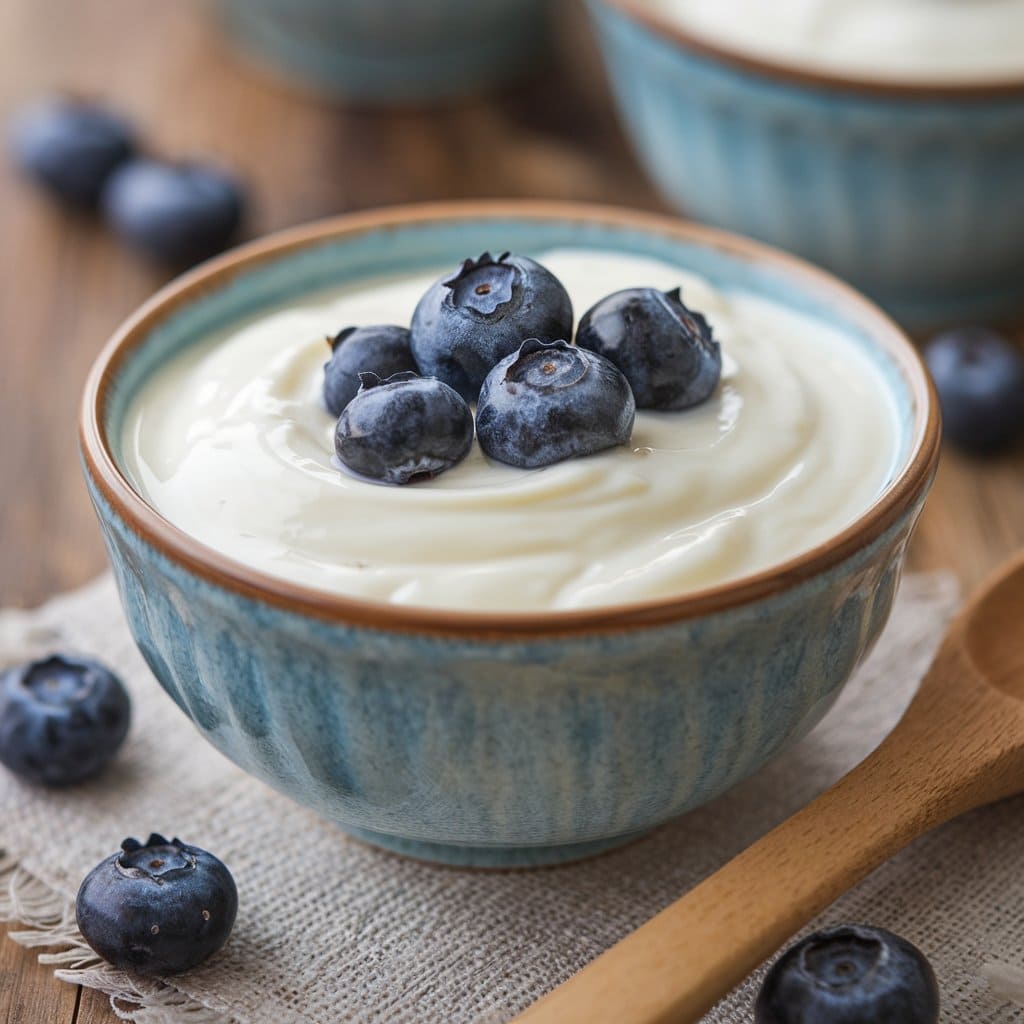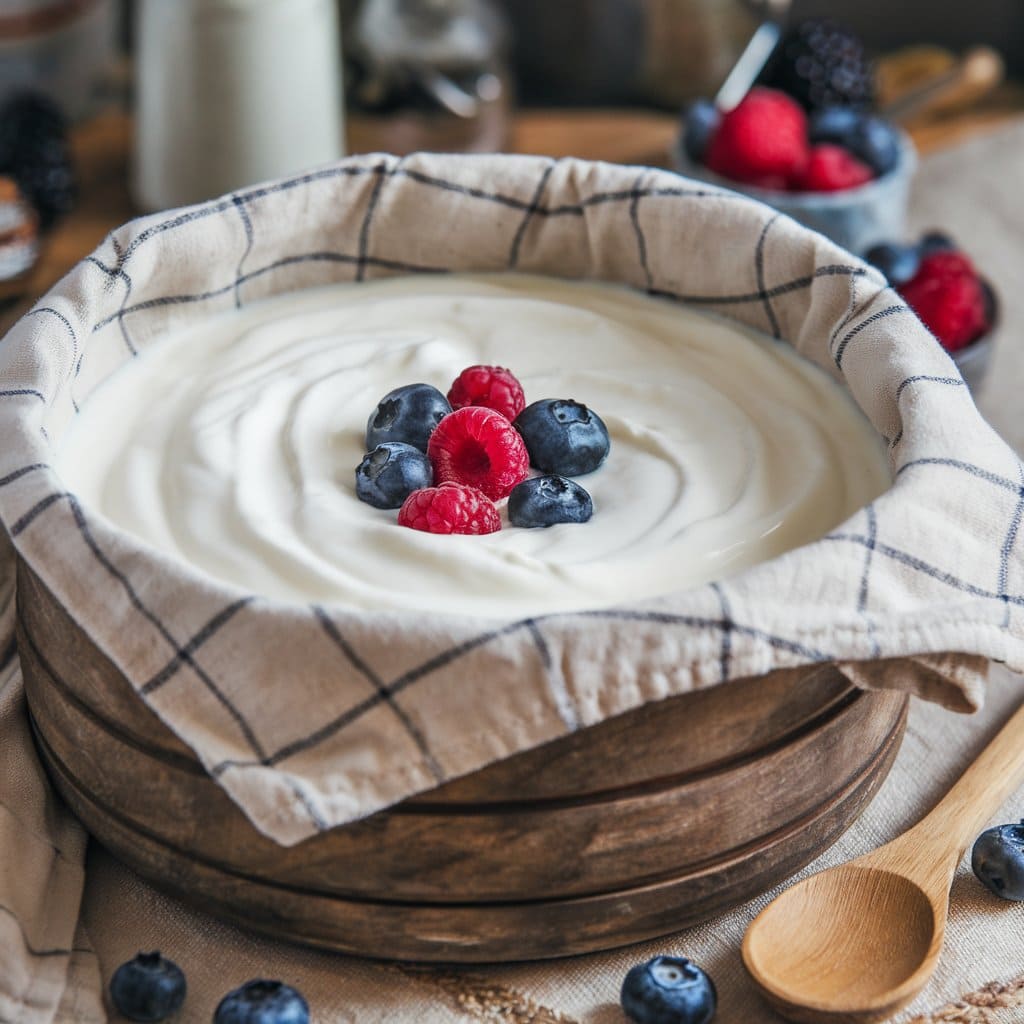Have you ever wondered how to make creamy, velvety yogurt right in your kitchen? Making homemade yogurt is easier than you think, and it brings with it the joy of knowing exactly what goes into your food. Plus, it’s incredibly rewarding to transform simple ingredients into a rich and wholesome staple that can be enjoyed in countless ways.
Whether you love yogurt for its creamy texture, probiotic benefits, or versatility in sweet and savory dishes, this recipe is for you. Let’s dive into the art of creating yogurt that rivals store-bought versions in both taste and quality—all from the comfort of your home!

Ingredients
- 1 liter (4 cups) of whole milk (or milk of your choice)
- 2 tablespoons plain yogurt with live active cultures (as a starter)
Nutrition Information (Per Serving)
- Serving Size: 1/2 cup
- Calories: 100
- Sugar: 7g
- Sodium: 50mg
- Fat: 5g
- Saturated Fat: 3g
- Unsaturated Fat: 2g
- Trans Fat: 0g
- Carbohydrates: 8g
- Fiber: 0g
- Protein: 6g
- Cholesterol: 20mg
Why You’ll Love This Recipe
- Healthy and Natural: No additives or preservatives, just wholesome ingredients.
- Budget-Friendly: A fraction of the cost of store-bought yogurt.
- Customizable: Control the sweetness, tanginess, and thickness to your preference.
- Easy to Make: Requires minimal equipment and effort.
- Environmentally Friendly: Less packaging waste compared to store-bought options.
Ingredients and Substitutions
1. Milk
The quality of the milk greatly influences the taste and texture. Use whole milk for richness or experiment with low-fat or non-dairy options like almond or soy milk.
2. Yoghurt Starter
A good starter yogurt is essential. Choose plain yogurt with live active cultures. Alternatively, powdered yogurt starters are available at specialty stores.
How to Make Homemade Yoghurt (Step-by-Step)
Step 1: Heat the Milk
Start by heating the milk to 180°F. This process helps break down proteins, ensuring a creamy texture. Use a thermometer to monitor the temperature accurately.
Step 2: Cool the Milk
Cooling the milk to 110°F is crucial. Too hot, and the cultures will die; too cold, and fermentation won’t occur.
Step 3: Add the Starter
Mixing a small amount of yogurt into the milk introduces live cultures, kickstarting the fermentation process.
Step 4: Incubate the Yoghurt
Maintain a warm environment for steady culturing. An oven with the light on works well, or use a dedicated yogurt maker for consistency.
Step 5: Refrigerate and Enjoy
Once set, refrigerate the yogurt to stop the fermentation. Serve plain or jazz it up with honey, granola, or fruit.
Expert Tips for Success
- Sterilize Everything: Ensure all tools and containers are clean to avoid contamination.
- Consistency Is Key: Stirring gently prevents the yogurt from becoming too thin.
- Time for Tang: The longer you incubate, the tangier the yogurt. Start with 6 hours and adjust to taste.
- No Disturbing: Don’t shake or move the yogurt while it’s culturing to ensure proper setting.
- Trial and Error: If your first batch isn’t perfect, adjust the milk-to-starter ratio or incubation time.
Variations and Customizations
Greek Yoghurt
Strain the yogurt through cheesecloth for a thick, creamy consistency.
Flavored Yoghurt
Add vanilla extract, fruit purée, or sweeteners like honey post-incubation.
Non-Dairy Options
Use coconut milk or almond milk. Add a thickener like agar-agar for better results.

Storage and Reheating Instructions
Storage
Store homemade yogurt in an airtight container in the fridge for up to 7 days.
Reheating
Homemade yogurt doesn’t require reheating but can be warmed slightly for recipes like marinades or sauces.
Serving Suggestions
- Breakfast Bowl: Top with granola, fresh fruit, and a drizzle of honey.
- Savory Dip: Mix with garlic, cucumber, and herbs for a tzatziki-style dip.
- Smoothies: Blend with your favorite fruits and a splash of juice or milk.
- Dessert: Layer with crushed cookies and berries for a parfait.
Frequently Asked Questions (FAQs)
Q: Can I use flavored yogurt as a starter?
A: Plain yogurt is best. Flavored yogurt might contain additives that interfere with culturing.
Q: Why didn’t my yogurt set?
A: The milk may have been too hot or cold during incubation, or the starter lacked active cultures.
Q: Can I freeze yogurt?
A: While you can freeze yogurt, the texture may change slightly. It’s best used in smoothies or recipes after freezing.
Q: How can I make thicker yogurt?
A: Strain it through cheesecloth or use higher-fat milk. Adding powdered milk can also help.
Related Recipes
- Greek Yoghurt Pancakes: Fluffy pancakes made with tangy yogurt.
- Yoghurt Parfaits: Perfect for breakfast or a healthy dessert.
- Labneh: A creamy, spreadable yogurt cheese.
Conclusion
Homemade yogurt is a simple yet rewarding kitchen project. It’s healthier, more cost-effective, and customizable compared to store-bought varieties. Whether you enjoy it plain, sweetened, or as part of a recipe, this yogurt will elevate your meals. Try it today and discover the joy of creating something so versatile and delicious from scratch!
Ready to try this recipe? Let us know how your homemade yogurt turns out in the comments below!

Homemade Yogurt
Ingredients
- 1 l whole milk
- 2 tbsp plain yogurt (with live active cultures)

